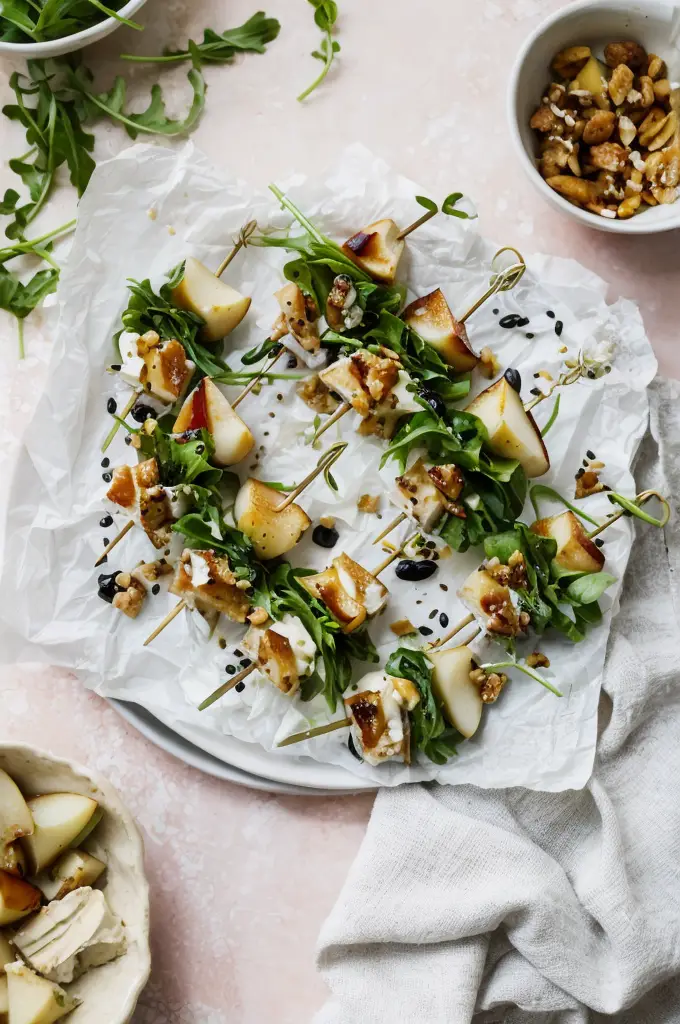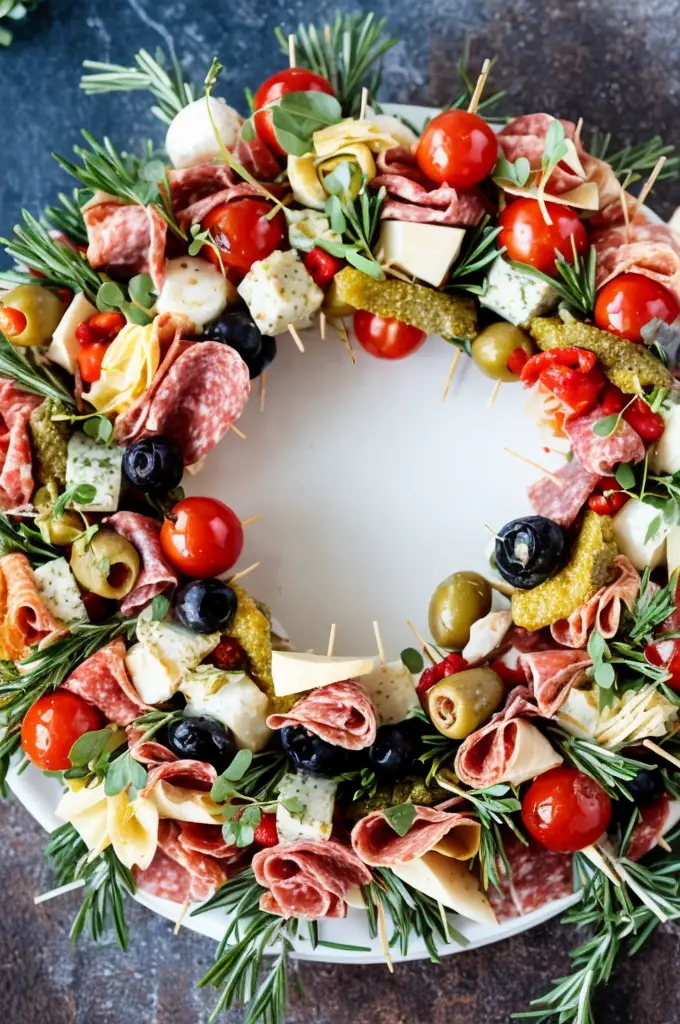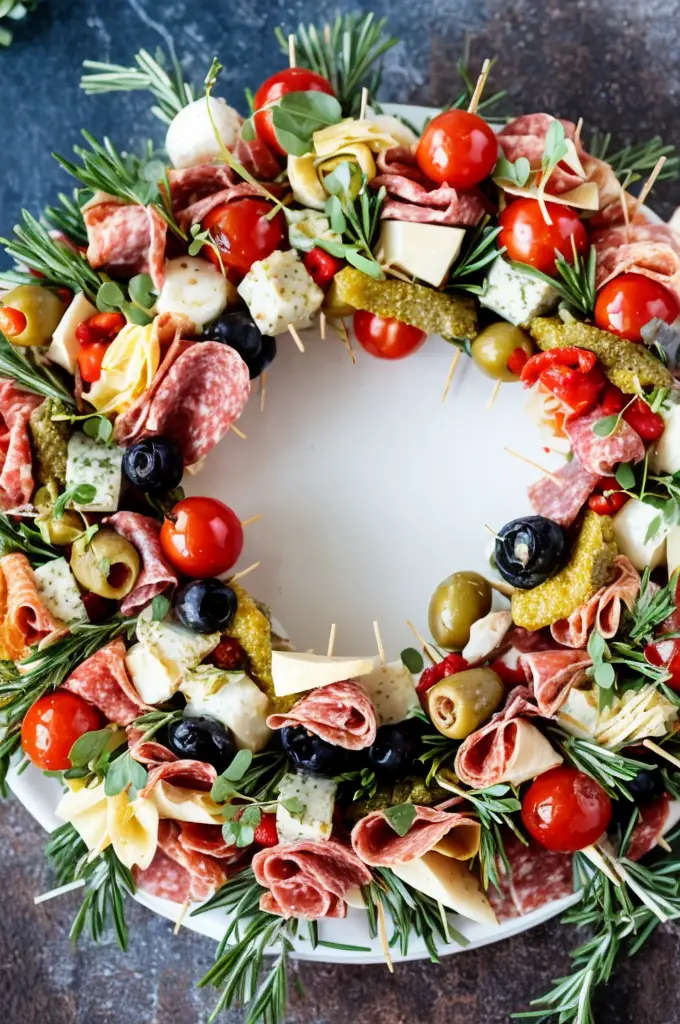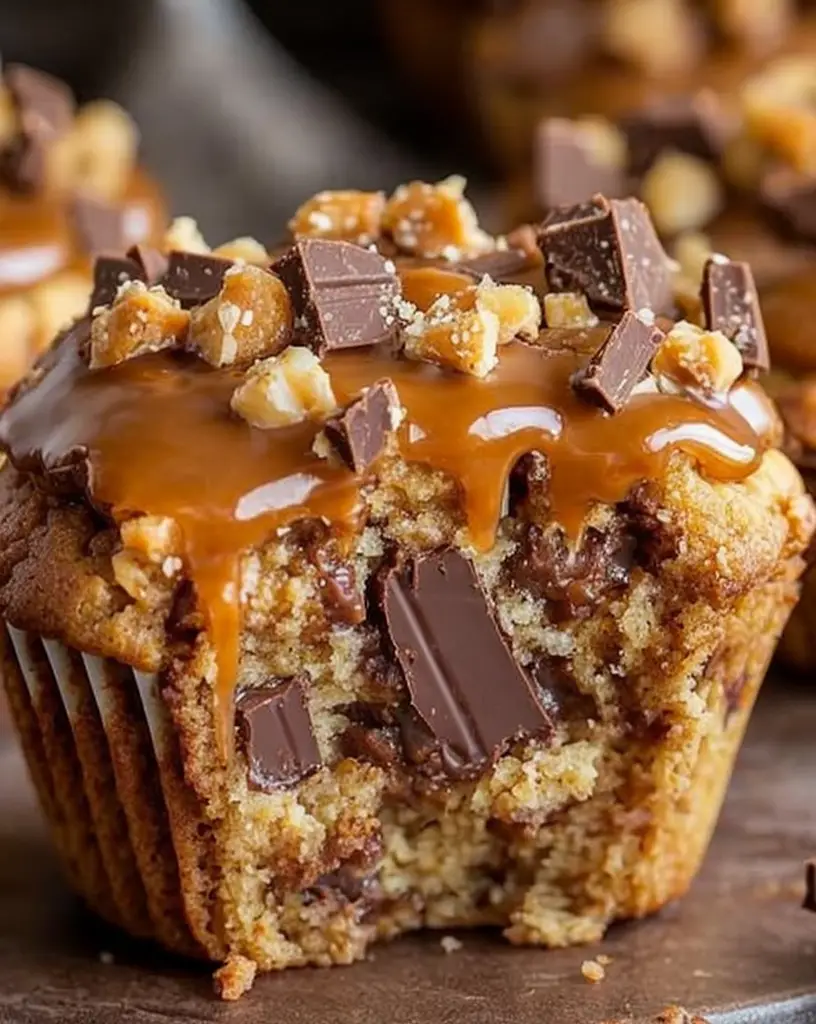Delicious Pear and Brie Cheese Salad Skewers Recipe: A Perfect Appetizer for Any Gathering
Indulge in the delightful combination of flavors with our Delicious Pear and Brie Cheese Salad Skewers Recipe. This easy-to-make appetizer not only bursts with freshness but also offers a unique blend of creamy brie and the juicy sweetness of ripe pears. Perfect for summer gatherings, picnics, or as an elegant starter for dinner parties, these skewers will impress your guests and tantalize their taste buds. Each bite provides a satisfying contrast of textures: the smoothness of the brie balances beautifully with the crispness of fresh greens and the tender bite of juicy pear.
The beauty of this salad skewers recipe lies in its simplicity. You’ll find that no cooking is required, making it incredibly convenient for busy hosts. Preparing this dish takes just 15 minutes, keeping stress levels low while still allowing you to serve a visually stunning platter. Also, customizable to personal tastes, the ingredients can be adjusted to feature seasonal fruits or different types of cheese, ensuring your skewers are always fresh and exciting.
Quick Recipe Highlights
- Flavor Profile: The sweet flavor of ripe pears complements the earthy richness of brie, creating a balanced taste that is refreshing and light.
- Texture: The smooth, creamy texture of brie contrasts with the firm, juicy bite of the pears, while the crispy greens add a crunch.
- Aroma: The subtle nuttiness of brie pairs beautifully with the sweet aroma of fresh fruit, inviting you to indulge.
- Visual Appeal: These skewers are visually striking with the contrasting colors of green, yellow, and white, making them a delightful centerpiece on any table.
- Skill Level Needed: This is an easy recipe suitable for novice cooks, requiring no prior cooking experience or special skills.
- Special Equipment: You will need skewers or toothpicks to assemble the salad skewers, along with a cutting board and knife for preparation.
Recipe Overview
- Difficulty Level: This recipe is classified as easy due to its minimal preparation and no cooking required, making it accessible for everyone.
- Category: The Delicious Pear and Brie Cheese Salad Skewers Recipe falls under appetizers and finger foods, perfect for gatherings.
- Cuisine: It is inspired by French cuisine, known for its sophisticated use of cheese paired with fruits, highlighting gourmet flavors.
- Cost: The ingredients are relatively inexpensive, with costs primarily coming from the brie cheese and fresh produce, making it an affordable option for entertaining.
- Season: This recipe is best enjoyed in late summer to early fall when pears are in season, ensuring the ripeness and sweetness of the fruit.
- Occasion: Ideal for casual summer parties, potlucks, or elegant dinner parties, these skewers bring a touch of sophistication to any occasion.
Why You’ll Love This Recipe
The combination of sweet pears and creamy brie is not only delicious but also offers an appealing contrast that delights the senses. With each bite, the juicy fruit mingles with the rich cheese, resulting in a culinary experience that balances both savory and sweet flavors. This unique pairing ensures a satisfying taste while providing freshness, making it feel light yet indulgent. Whether served as a party appetizer or a light snack, this salad recipe captures the essence of satisfying but simple fare.
In terms of preparation, you will appreciate how quick and effortless this recipe is. Designed for minimal fuss, it allows you to spend more time with your guests rather than slaving away in the kitchen. Simply slice the pears, cube the cheese, and assemble the skewers—it’s as easy as that! You’ll be able to whip up this recipe in about 15 minutes, ensuring you can easily accommodate spontaneous gatherings.
Nutritionally, the pears are a great source of dietary fiber and essential vitamins, while brie offers protein and calcium. Together, they create a snack that’s not only tasty but also nutritious. When you’re looking for a guilt-free solution to satisfy your cravings, this recipe is an excellent option.
When entertaining guests, these delicious skewers provide an elegant presentation that always impresses. The combination of the richness of cheese and the sweetness of fruit elevates them beyond typical snacks, allowing for a sophisticated dining experience. It’s a surefire way to make your gathering memorable while providing an element of fun as guests pick and choose their preferred skewers.
Lastly, the affordability of this recipe ensures that you don’t have to break the bank to create an impressive appetizer. With simple, readily available ingredients, anyone can make this dish without any high-cost items, enabling you to host gatherings while remaining budget-friendly.
Historical Background and Cultural Significance
The origins of pairing cheese and fruit can be traced back to ancient civilizations where rich dairy products were enjoyed with fresh, local produce. This tradition has evolved over centuries, particularly in European cuisine, where the balance of flavors is a hallmark of many well-composed dishes. The French have played a significant role in popularizing cheese boards that include fruits, making this a widely appreciated culinary combination.
Culturally, cheese holds a significant place in many European diets, with specific contexts in which it is consumed. For instance, artisan cheeses, such as brie, are often celebrated in France, where they are paired with a variety of accompaniments, including fruits, nuts, and bread. This practice highlights the idea of gastronomy as an art form and emphasizes the importance of sourcing high-quality ingredients.
Over the years, the recipe has metamorphosed, adapting to various dietary preferences and ingredient availability. The Delicious Pear and Brie Cheese Salad Skewers Recipe reflects this evolution, demonstrating a playful and modern take on a classic tradition. Seasonal variations allow for diverse ways to enjoy this combination throughout the year, ensuring that flavors remain vibrant and enticing.
Regional adaptations have further diversified how cheese and fruit are paired worldwide. In some countries, a selection of cheese and fresh fruit is served as part of an antipasto spread, while in others, cooked fruits might accompany cheese boards. The versatility of cheese and fruit pairings exemplifies a culinary practice that transcends borders, inviting endless creativity in preparation and presentation.
Ingredient Deep Dive
Pears
Pears have a rich history dating back to ancient Greece and Rome, where they were praised for their sweet and juicy flesh. The fruit symbolizes prosperity and nourishment across cultures. Nutritionally, pears are a fantastic source of fiber, vitamin C, and antioxidants, making them a healthy choice in any recipe. When selecting pears for this skewer recipe, look for ones that yield slightly to pressure and have a fragrant aroma. Store ripe pears in the fridge to prolong freshness, and consider alternative fruits like apples or figs if pears are out of season.
Brie Cheese
Brie cheese, with its soft rind and creamy interior, hails from France, where it’s celebrated for its rich flavor and luxurious texture. It is a high-quality cheese packed with protein, calcium, and essential fats. When choosing brie, opt for cheeses with a creamy, supple texture and a fresh aroma. Store brie in the cheese drawer of your refrigerator, wrapped tightly to maintain its quality. While brie is a fantastic pairing, you could substitute it with camembert or another mild cheese for a different taste experience.
Common Mistakes to Avoid
- Overripe Peaches: Selecting overly ripe pears can lead to undesirable mushiness. Aim for pears that are firm yet yield slightly to pressure.
- Skewer Stability: Not ensuring the ingredients are balanced on the skewers may lead to them falling apart. Place heavier items on the bottom for better stability.
- Serving Temperature: Serving the salad skewers either too cold or too warm can impact flavor. Allow them to sit out for a few minutes before serving for the best taste experience.
- Inappropriate Pairings: Not considering complementary flavors can result in less enjoyable skewers. Always pair fruits with cheeses that contrast in flavor profiles.
- Neglected Garnishes: Forgetting to add fresh herbs or a drizzle of balsamic glaze can make the dish visually and flavor-wise less appealing.
- Preparing Too Early: Assembling skewers too long before serving can cause the ingredients to oxidize. Prepare them no more than an hour in advance.
- Using Inferior Quality Ingredients: Skimping on cheese or fruit quality can detract from the overall experience. Always opt for fresh and gourmet choices for the best results.
- Overcomplicating the Recipe: Adding too many ingredients can overwhelm the flavor profile. Keep it simple to let the pears and brie shine through.
- Ignoring Dietary Restrictions: Not considering guests’ dietary needs may lead to uneaten skewers. Always have a variety of options available.
- Poor Presentation: Serving the skewers haphazardly can diminish their visual appeal. Arrange them intentionally on a beautiful platter for the best presentation.
Essential Techniques
Cutting Fruits
Properly cutting fruits like pears is crucial to maintaining the visual appeal of your skewers. Aim for even, bite-sized pieces to ensure easy handling. Using a sharp knife will provide cleaner cuts, which prevents the fruit from browning quickly. Watch for common pitfalls, such as cutting fruits before they are fully ripe, leading to excessive juiciness, or unevenness that affects presentation.
Assembling Skewers
Assembly is key to creating visually appealing skewers. Begin with a base layer of greens, then add alternating pieces of pears and brie, ensuring a beautiful contrast. Be cautious not to overcrowd the skewers; too much weight can cause them to snap. Pay attention to the arrangement of colors and textures for maximum impact.
Pro Tips for Perfect Delicious Pear and Brie Cheese Salad Skewers
– Choose ripe but firm pears that will hold their shape on the skewer and provide a sweet, juicy bite.
– When selecting brie, look for high-quality artisan options for a richer flavor.
– Consider marinating the pear slices in a splash of lemon juice to preserve their color and enhance their tartness.
– Serve with a side of balsamic reduction as a dipping sauce to add a tangy element to the skewers.
– Opt for decorative skewers or toothpicks that complement the dish’s aesthetic for added flair.
– Prepare extra skewers to cater for unexpected guests and ensure everyone has a taste.
– Experiment with adding nuts or prosciutto between the layers for added crunch and flavor.
– Arrange the skewers on a beautiful platter, garnished with fresh herbs or edible flowers for an elegant touch.
Variations and Adaptations
For regional variations, explore using local fruits that are fresh and in season, such as figs, peaches, or apples instead of pears. Seasonal adaptations allow you to enhance flavor profiles. In the fall, consider adding roasted seasonal veggies for a heartier skewer. For dietary modifications, use vegan cheese alternatives to make the dish entirely plant-based, ensuring everyone can enjoy it.
If you’re looking to enhance flavors, try different cheese pairings such as goat cheese for a tangy contrast or sharp cheddar for a bolder taste. Texture modifications could include adding crispy bacon or toasted nuts for a savory crunch. Presentation alternatives might involve serving the skewers in small cups with dipping sauces on the side for easy handling.
Serving and Presentation Guide
Plating techniques are essential to showcasing your Delicious Pear and Brie Cheese Salad Skewers. Arrange them in a circular pattern on a large white platter to draw the eye and make the colors pop. Garnishing the dish with fresh herbs, like basil or mint, will elevate the dish’s appearance. Traditional accompaniments, such as crackers or French baguette slices, can be served alongside for an appealing contrast.
For modern servings, consider individual servings in small jars or cups for a fun and trendy presentation. Be mindful of temperature; these skewers should be served at room temperature to ensure the best flavor experience. Lastly, with portion control in mind, serve 2-3 skewers per guest, allowing for satisfaction without overindulgence.
Wine and Beverage Pairing
When it comes to wine pairings, a chilled Chenin Blanc or a light Rosé complements the sweet and creamy notes of the pears and brie wonderfully. If looking for non-alcoholic alternatives, consider sparkling apple cider or a refreshing mint lemonade that can balance the flavors beautifully.
Additionally, coffee or tea aficionados might enjoy a light herbal tea to accompany these skewers, offering a soothing contrast to the richness of this appetizer. Always serve drinks chilled, particularly white wines and ciders, to ensure the best pairing experience.
Storage and Shelf Life
To keep your Delicious Pear and Brie Cheese Salad Skewers fresh, store them in an airtight container in the refrigerator for up to two days. Ensure you layer parchment paper between layers to prevent moisture buildup and maintain texture. When assembled, the skewers should be consumed fresh to enjoy the best taste and appearance. If you need to reheat leftover ingredients, consider allowing them to come to room temperature before serving again, avoiding the microwave to reduce the risk of melting the cheese excessively.
If you’re considering freezing leftover ingredients, do so before assembly, as the texture of the fruit and cheese may degrade after freezing, impacting later preparation.
Make Ahead Strategies
To streamline preparation, consider slicing the pears and cheese in advance, storing them in separate airtight containers until ready to assemble. You can also wash and dry greens a few hours ahead of time, keeping them crisp for serving. The skewers can be assembled and kept in the refrigerator under a damp paper towel for up to an hour before guest arrival, minimizing last-minute stress.
To maintain quality, avoid placing the skewers on ice as condensation can cause the cheese to become watery. Instead, prepare to serve them on a warm summer day with ample time for guests to mingle before enjoying.
Scaling Instructions
For halving the recipe, simply divide the quantities of all ingredients in half while maintaining the preparation time. Doubling or tripling the recipe can be easily done, ensuring that you have ample skewers for larger gatherings; however, when scaling up, consider the size of your serving platter to allow for a beautiful presentation. Keep in mind that assembly time may increase slightly due to the volume.
Storage considerations also become important at larger scales; ensure adequate refrigeration is available after prep to maintain freshness.
Nutritional Deep Dive
Each serving of the Delicious Pear and Brie Cheese Salad Skewers provides a healthy balance of macronutrients. Expect approximately 150 calories per serving, with a blend of carbohydrates from the pears and proteins from the brie. Both pears and brie offer micronutrients, including vitamin A, calcium, and potassium, contributing to overall health.
This appetizers also supports dietary flexibility with its plant-based ingredients. For weight management, consider portion control by serving smaller quantities while allowing guests to return for seconds without excess waste.
Dietary Adaptations
For gluten-free options, ensure all components are certified gluten-free, especially any sauces or dips served alongside. Dairy-free variations can be accommodated with coconut cream cheese or other vegan alternatives to brie for a similar creamy texture without dairy.
If catering to specific diet plans like low-carb or keto, opting for lower-carb fruits and cheeses can make this a delightful option. Additionally, those on Paleo diets can also substitute the cheese with nuts or avocados for a creamy quality while remaining true to dietary restrictions.
The Recipe
Delicious Pear and Brie Cheese Salad Skewers
Serves: 6 servings
Prep Time: 15 mins
Cook Time: 0 mins
Total Time: 15 mins
Kitchen Equipment Needed
- Skewers or toothpicks
- Cutting board
- Knife
- Airtight containers for storage
Ingredients
- 3 ripe pears, sliced
- 8 oz brie cheese, cut into cubes
- 2 cups mixed greens (arugula, spinach)
- Balsamic reduction for drizzling (optional)
- Fresh basil for garnish (optional)
Directions
- Prepare all ingredients by slicing pears and cubing brie cheese.
- Assemble the skewers by alternating pieces of pear and brie cheese, leaving space for greens.
- Add greens onto each skewer, ensuring balance in weight.
- Drizzle with balsamic reduction if desired and garnish with fresh basil.
- Serve immediately or refrigerate for up to an hour before serving.
Recipe Notes
- Feel free to substitute pears with seasonal fruits like figs or seasonal apples.
- Can add nuts (walnuts or pecans) for an extra delicious crunch.
Troubleshooting Guide
If you experience texture issues such as overly mushy fruit, ensure to select pears that are ripe yet firm when preparing the skewers. If flavor balance seems off, try adjusting the brie volume or drizzling a bit more balsamic reduction for added depth.
Temperature problems may occur if skewers are prepared too early; always allow them to rest at room temperature for the best flavor. If equipment challenges arise, ensure sharp knives are employed for all preparations to minimize struggle.
Should you need ingredient substitutions, always consider seasonal fruits or local cheese varieties that provide comparable textures. Timing concerns may arise if skewers were prepared too early – remember to keep them covered in the fridge, but not for too long before serving to maintain optimal quality.
Recipe Success Stories
Our community has shared their creative adaptations of this Delicious Pear and Brie Cheese Salad Skewers Recipe, showcasing its versatility. Variations such as adding prosciutto have received rave reviews for adding a savory twist to this already sweet and creamy starter. Many have enjoyed sharing alongside their cheese boards during gatherings, elevating their entertaining game.
Readers have also shared that their children loved assembling the skewers themselves, making it a fun activity for family bonding time. Others noted that the vivid colors and fresh ingredients made for stunning social media photos, highlighting the appetizing nature of this dish. Recipe tips on making the skewers more visually appealing have continued to roll in, inspiring greater creativity in presentation.
Frequently Asked Questions
Can I make these skewers in advance?
Yes, you can prepare the ingredients ahead of time, but it’s best to assemble the skewers no more than an hour before you plan to serve them to maintain freshness and crispness.
What are some good substitutes for brie cheese?
If you don’t have brie, you could use camembert, goat cheese, or cream cheese for a different flavor profile. Each will provide a creamy texture.
Are there any other fruits that pair well with brie?
Absolutely! Other fruits such as figs, apples, or even grapes work beautifully with brie and can add diverse flavors and textures to your skewers.
Can I use different greens?
Definitely! Feel free to use any fresh greens you prefer, such as arugula, spinach, or kale, to complement the flavors of the brie and pears.
Is this recipe gluten-free?
Yes, this recipe is gluten-free as it uses only fresh fruit and cheese. Ensure any garnishing or accompanying sauces are also gluten-free.
How long can I store leftover skewers?
Leftover skewers should be consumed within two days when stored in an airtight container in the refrigerator. However, they are best eaten fresh.
What drinks pair well with this dish?
Chenin Blanc or light rosé wines are excellent for pairing. For non-alcoholic options, try sparkling apple cider or herbal tea to balance the flavors.
Can I make this recipe vegan?
Yes, you can make this recipe vegan by substituting brie with a nut-based cheese or vegan cream cheese, and ensure all other components are plant-based.
What kind of skewers can I use?
You can use wooden or metal skewers. Just make sure to soak wooden skewers in water if you are going to put them on the grill or cook them.
Do I need to peel the pears?
No, you do not need to peel the pears. The skin adds fiber and texture to the dish; just make sure to wash them thoroughly before use.
Additional Resources
If you’re interested in exploring more related recipes, consider checking out our fruit and cheese platter ideas or exploring appetizers that emphasize seasonal produce. Additionally, our technique guides on cheese carving and cheese pairing suggestions can enhance your culinary skills. Don’t forget to read up on ingredient information to get the most out of your purchases, while our equipment recommendations can provide ideas for the best cookware and serveware to use for this recipe.
Join the Conversation
We invite you to share your experience with our Delicious Pear and Brie Cheese Salad Skewers Recipe! Connect with us on social media by sharing your photography tips and enjoyed variations. Your feedback is invaluable and helps us continue to provide the best recipe recommendations. Engage with fellow culinary enthusiasts and inspire them with your personal adaptations and suggestions for making this delightful skewers recipe your own.




